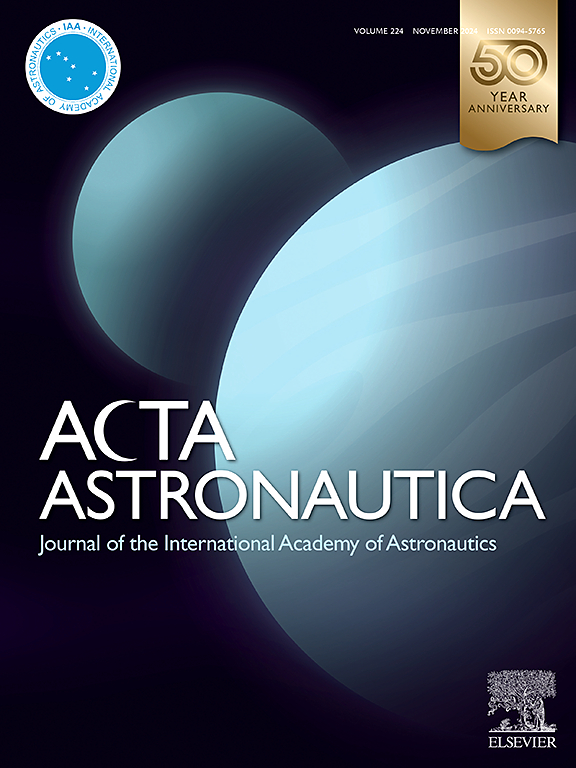Experimental study on abnormal spark discharge characteristics of a Hall thruster
IF 3.4
2区 物理与天体物理
Q1 ENGINEERING, AEROSPACE
引用次数: 0
Abstract
Abnormal spark discharge could cause a Hall thruster to malfunction, and numerous experiments have pinpointed the cause as exfoliation of channel wall deposits. Due to the high randomness and uncertainty of natural abnormal spark discharge, a device was designed to actively trigger abnormal spark discharge to imitate the process by which artificial flakes similar to the exfoliated deposit enter the discharge channel. Then, discharge experiments were conducted by releasing flakes made of graphite with a volume of 2 × 2 × 0.5 from the top of the discharge channel. During the experiment, the changes in discharge current, discharge voltage, shell-to-ground potential, ion current density, and cathode-to-ground potential were monitored, and transient spark images were captured at the moment of abnormal discharge. It was found that the current pulse peak has 2–3, 3–4, or 18–22 times the normal discharge current types, and the larger the current pulse peak, the shorter the pulse duration. It was also found that the brightness of the spark corresponds to the amplitude of the current disturbance. By comparing and analyzing both the monitored discharge parameter curves and captured spark images, it was concluded that natural abnormal spark discharge is the result of interaction between the exfoliated deposit and electrons rather than ions.
霍尔推力器异常火花放电特性实验研究
异常的火花放电可能导致霍尔推进器失灵,许多实验已经确定原因是通道壁沉积物的剥落。针对自然异常火花放电的高随机性和不确定性,设计了一种主动触发异常火花放电的装置,模拟类似剥落沉积物的人工薄片进入放电通道的过程。然后,从放电通道顶部释放体积为2 × 2 × 0.5 mm3的石墨薄片,进行放电实验。实验过程中监测放电电流、放电电压、壳对地电位、离子电流密度、阴极对地电位的变化,并捕捉异常放电瞬间的瞬态火花图像。研究发现,电流脉冲峰值有正常放电电流的2-3倍、3-4倍、18-22倍,且电流脉冲峰值越大,脉冲持续时间越短。还发现火花的亮度与电流扰动的幅度相对应。通过对监测的放电参数曲线和捕获的火花图像进行对比分析,认为自然异常火花放电是剥落沉积物与电子而非离子相互作用的结果。
本文章由计算机程序翻译,如有差异,请以英文原文为准。
求助全文
约1分钟内获得全文
求助全文
来源期刊

Acta Astronautica
工程技术-工程:宇航
CiteScore
7.20
自引率
22.90%
发文量
599
审稿时长
53 days
期刊介绍:
Acta Astronautica is sponsored by the International Academy of Astronautics. Content is based on original contributions in all fields of basic, engineering, life and social space sciences and of space technology related to:
The peaceful scientific exploration of space,
Its exploitation for human welfare and progress,
Conception, design, development and operation of space-borne and Earth-based systems,
In addition to regular issues, the journal publishes selected proceedings of the annual International Astronautical Congress (IAC), transactions of the IAA and special issues on topics of current interest, such as microgravity, space station technology, geostationary orbits, and space economics. Other subject areas include satellite technology, space transportation and communications, space energy, power and propulsion, astrodynamics, extraterrestrial intelligence and Earth observations.
 求助内容:
求助内容: 应助结果提醒方式:
应助结果提醒方式:


